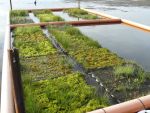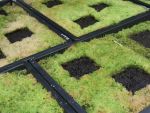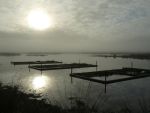MOOSFARM

Joint project: Sphagnum produced on floating vegetation as a sustainable peat substitute in commercial horticulture.
Optimal growth of Sphagnum requires continuously high water levels, which is one of the biggest challenges for Sphagnum cultivation on peat soil. Plant growth slows down when water levels are either too low or too high. Thus the cultivation of Sphagnum on floating rafts could be potentially beneficial because fluctuations in the water level can be avoided.
Suitable rafts were developed and tested in water-filled peat cuttings of raised bog remnants, former sand mining pits in Lower Saxony as well as in former water filled open cast lignite mines in the federal state of Brandenburg. Additionally, the horticultural series of tests were extended in order to introduce Sphagnum biomass as a basic ingredient in horticultural growing media.
Content and results
Different designs of floating material were tested for their suitability in greenhouse and outdoor trials (UG, HUB; advice by stfi). The successful design was then mechanically produced (mst) with the plant material (whole plants) already included on the surface. The results showed that Sphagnum palustre growing under a cover of straw had the highest yields (IASP, UG). Another promising approach involved the pre-cultivation of Sphagnum fragments before they were integrated into the raft material surface and placed on the water surface (NIRA).
During the trial period a number of problems arouse including erosion of vegetation by waves, physical destruction by birds, weeds and high saline concentrations within the water. Those factors have to be regarded when choosing the water bodies for Sphagnum production (HUB, UG).
A mechanical method of harvesting Sphagnum has not yet been tested, however harvesting technologies were already developed (ISAP).
Sphagnum biomass was processed into growing media (MoKuRa, KD, HUB) and successfully tested in horticultural trials (HUB).
The economical analysis of Sphagnum cultivation is mostly based on theoretical assumptions because commercial trials have not yet been commenced (UG). The calculations have shown that Sphagnum cultivation is not covering the costs so far because the production of the rafts is too expensive. However, profitability can be improved by higher revenues due to added value in specific niche markets as well as the payment for ecological and societal benefits of Sphagnum cultivation in form of subsidies.
Further research
Joint network partners
- University of Greifswald,
Institute of Botany and Landscape ecology (UG)* - Hartmann Ingenieure GmbH (HI)*
- Humboldt-University of Berlin,
Institute of horticultural sciences (HUB)** - Institute of Agricultural and Urban Ecological Projects
at the Humboldt-University in Berlin (IASP)* (network coordinator) - Klasmann-Deilmann GmbH (KD)*
- Torfwerk Moorkultur Ramsloh Werner Koch GmbH & Co. KG (MoKuRa)*
- mst-Dränbedarf GmbH (mst)*
- Niedersächsische Rasenkulturen NIRA GmbH & Co. KG (NIRA)*
- Saxonian Institute for Textile Research (stfi)**
* project partner ** contractor














